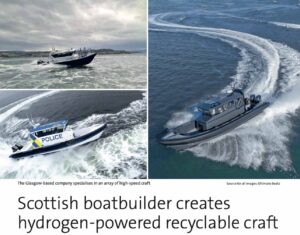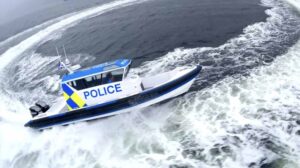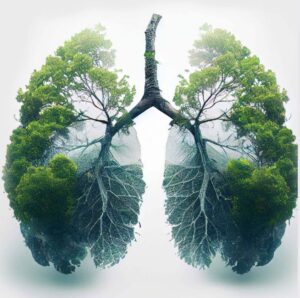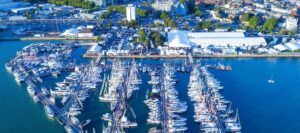Author: Julie Blackburn
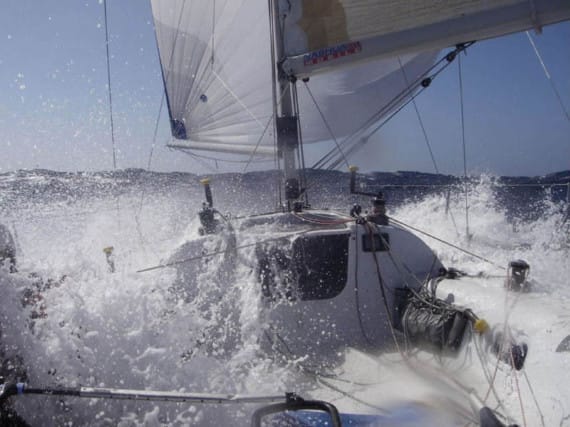
Jeroen Wats called a halt to a successful career designing and sailing racing yachts because he was concerned too many of them were ending up in landfill sites.
Now living in Castletown, Dutchman Jeroen thinks he has found the answer and he’s aiming his talents at designing a sustainable yacht for Olympic competition.
You’d think that sailing, both recreational and competitive, would be the ultimate environmentally-friendly pastime, powered almost completely by the wind.
You’d be wrong: yachts, especially racing yachts, are designed to be light and quick and, to achieve this, they are built from some very unpleasant materials, notably carbon fibre and glass fibre. Neither of these can be reused or recycled so, when they end their short lives, there is nowhere for them to go except into landfill.
According to Jeroen, the figures are staggering. He says: ’As an example between 2002 and 2012, just in Florida, 1.5 million boats ended up in landfill, just thrown away.
’In Europe 250 million kilos of glass fibre ends up in landfill every year: not just boats but wind turbine blades are made from glass fibre and you can do nothing else with it.’
Jeroen is now quite at ease with being called an eco-warrior but it wasn’t always the case.
When he began racing sailing yachts his major concern was speed.
In 2003 he took part in the transatlantic race from Cape Town to Rio de Janeiro as part of an eight-man crew on a boat named Madiba after Nelson Mandela. They won the race, covering the 4,000 nautical miles in 20 days, and raised a considerable sum of money for the Nelson Mandela Children’s Fund.
When he was asked to take part in subsequent races Jeroen decided that 20 days was a very long time to be at sea on a yacht with very few comforts. If he was going to do it again, he wanted to do it in no more than 16.
’So I gave up my job and moved to Cape Town to live there for five years and started building my first racing yacht, which I designed with a naval architect from San Diego. I participated in the same race again in 2006, and won again, in 16 days.
’At 37 foot, Windsong was the smallest boat in the field because I didn’t have more money to make it any bigger, but it was ridiculously fast. From the start line to the finish we were always number one.’
A report in the online Cape2Rio Race archive reads: ’On occasions notching up daily runs of nearly 300 miles, Windsong set a time of 16 days, two hours and 46 minutes, to take both line honours and the handicap trophy for the racing class.’
That really got Jeroen started on his career in yacht design.
He recalls: ’I started building purely racing yachts so then I developed a 26-foot racing yacht. These boats were sold all around the world, New York, Angola, Switzerland, Sweden, the Netherlands, Belgium, France, Spain, everywhere. They won everything and we won a lot of designer awards in the United States.’
But Jeroen had been experiencing a growing awareness that his industry was contributing to very real environmental damage.
He says: ’The more you do this kind of work, and the more you read about what you do, it’s a very, very double feeling. So on the one hand you make very cool-looking, super-fast sailing boats, which is a sort of boys’ dream come true but, on the other hand, with every boat you make you create an ecological timebomb.
’I thought: “I cannot go on with this every year, this is really, really bad”, and after 16 years I thought: “This is enough.”
’There is no end-of-life solution for these boats as, at a certain point, there is a fatigue factor as the boats get old and worn out and, for a racing yacht, that’s a pretty short time because they’re super light.
’Also, development of technology means newer, faster designs are coming out all the time.’
Jeroen’s concern for the environment began to influence every aspect of his yacht design, starting with the basic build material. Wanting to get away completely from using glass fibre and carbon fibre, he set about developing a new material that would solve the problem.
He says: ’I wanted to do it in a sustainable way, to find a solution to replace glass fibre and carbon fibre.’
After two years’ testing, he has come up with Danu, which is comprised of a combination of styrene-free resin and sustainable fibres, and is in the final stages of patenting.
’It’s the coolest thing I’ve ever done,’ says Jeroen.
It’s also an exciting commercial prospect: not only is Danu potentially ideal for building sailing yachts, being light and very, very strong, it could also be used to make wind turbine blades.
And, just like sailing, wind turbines also are not quite as environmentally friendly as you might have thought when you look deeper into their story. In theory, wind turbines are almost 90% recyclable, but their blades, made largely from fiberglass, carbon fibres and balsa wood, have proven challenging to break down, process and recycle.
It is estimated that the global offshore wind industry will need to decommission 85GW of capacity – including 325,000 blades – by mid-century. This will mean that an estimated 43 million tonnes of redundant blade material will end up in landfill between today and 2050 worldwide.
But Jeroen has his sights set on a very particular – and special – target. To showcase the new development he wants to use Danu to build a 32-foot racing yacht that will ultimately be capable of winning at a future Olympics.
He says: ’The yacht will be sailed by Olympic degree sailors. The yacht is developed and designed for the Olympics and therefore we keep the racing scene purely for the purists of sailing.’
He has chosen to base his design company, TYNC Yacht Design, in the Isle of Man where he came to live nearly a year ago. It was, as he explains, a snap decision.
He says: ’Why did I come to live here? A very simple answer: the quality of life.
’In November 19, 2019 I came here for the day. I arrived by plane in the morning and left in the late afternoon and the weather was horrible: it was foggy and misty and cold – and I loved it here!
’The people were nice and warm and friendly and helpful you could see seals swimming around and it was like “wow”.’
It has proved a good place to focus on his ambition for the Olympics. And anyone who might have ideas of buying one of his new designs in the meantime will be disappointed.
Jeroen says: ’This is not for sale: it is only designed for one purpose. It’s the fastest and the meanest and there’s no comfort in it at all: it will be bouncy and nasty and wet and fairly testing – and fantastic!’
And it seems that the rest of the sailing world is also waking up to a more sustainable future: the Olympic committee for 2028 requires that 90% of the weight of the materials needs to be recyclable and World Sailing, the overall organiser of the sport, want to achieve this by 2030.
Jeroen says: ’We already exceed 90% by far, building the boat using Danu – we are already beyond that with this material. It will be a stronger, affordable, smart solution.
’It’s really exciting that we’re the first ones in the world doing this – and doing it in the world’s only whole-country Biosphere.’


